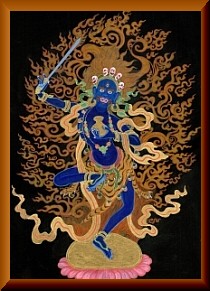Tantra
The Tantric path is also called the path of transformation. On this path it is recognized that if we are skillful, instead of rejecting the afflictive emotions that obscure our true nature, we can use them as a means to achieve transformation.

There are four kinds of Tantra in the Tantric teachings of the Bon tradition:
- Kriya Tantra and Charya Tantra (Lower Tantras)
- Father Tantra and Mother Tantra (Higher Tantras).
In the practice of Lower Tantra, practitioners visualize themselves as deities and completely transform themselves into that deity. They embody all of that deity’s emotions, strengths, wisdom and healing potential. The practitioner visualizes the whole universe as pure and perfect, and all beings as wisdom beings. Every sound, smell, taste, touch, and sight is perfect and pure by its nature.
The process of practice involves three beings, the knowledge being, the symbolic being, and the action being.
The symbolic being is the act of bringing everything into the field of our consciousness or awareness. This being can be the Mandala that we are visualizing, peaceful or wrathful deities, the deity’s mantra, or it can be any form of subtle energies.
The knowledge being is the positive qualities that we see in the deity, feel in the mantra, or that we invoke in the deity with our innate Buddha nature. When we unify these two beings into one, this is called the action being.
The action being is the transformed state of our being. It is compassionate and free of guilt, anger, or fear.
Another very important aspect found in Tantra is the teacher and student relationship. The unification of wisdom and method is the path of transformation, and it is the heart of tantric practice.
We visualize ourselves as the deity because we are Buddha by nature. We have the potential to be who we truly are, to be a compassionate being, to be loving and caring. But we are constantly so distracted in our every day life, that it is hard for us to recognize our innate potential to be good. We have been disconnected from our true nature through our conditioning and distraction.
The practice of deity visualization not only gives us blessings and strength, but also helps us to reconnect with our innate potential. Visualization practice is about connecting to ourselves. When we are disconnected, it is difficult to visit that place again. When we visualize a deity and invoke a particular quality that we need, this actually brings that quality back into our lives from within ourselves.
Teaching on the practice of higher Tantra
In the higher tantric practice, the essence of the practice is the unification of bliss and emptiness. This practice involves two stages, the generation stage where we build up the visualization, and the completion stage where we manifest the essence of the practice.
Bliss can be any sensational feeling. The sensation of bliss is often depicted in the tantric practice with the Yab-Yum deities (the pair of male and female deities) through the sensation of sexual bliss.
It is said that sexual feeling is the most intense and powerful sensation of all. Because it can affect our mind and body so strongly, there is a tendency of becoming attached. This is why in the practice of the generation stage, our feeling or sensation is unified with emptiness. When we practice this unification, it becomes the quality of mind into which we transform ourselves.
The unification of feeling and emptiness is understood as wisdom. Our feeling of any kind, blissful or chaotic, must not mix with desire-attachment. When we practice, our feeling or perception must be free from afflicted thoughts.
If our feeling is mixed with desire-attachment, there is a tendency of developing conditioning such as clinging, craving, and addiction.
If our feeling is mixed with emptiness, it become a skillful means to transform difficulties or the suffering of life.
In the higher tantric practice, emptiness is referred to as the object of our meditation. Experience of bliss or any sensation or emotion is referred to as the subject who is meditating. This recognition is wisdom. It is knowledge or our innate awareness. It is important to have awareness that recognizes subject and object, and to recognize the object as emptiness.
If we can do this, we will be freeing ourselves from becoming the victim of desire-attachment or afflictive emotions such as grasping, craving, clinging, or aversion.
The recognition of bliss or experience as the subject has a quality of acceptance and openness. We are accepting our state of being at that very moment. But it is even more important not to let our experience become conditioning.
By Tempa Dukte Lama

